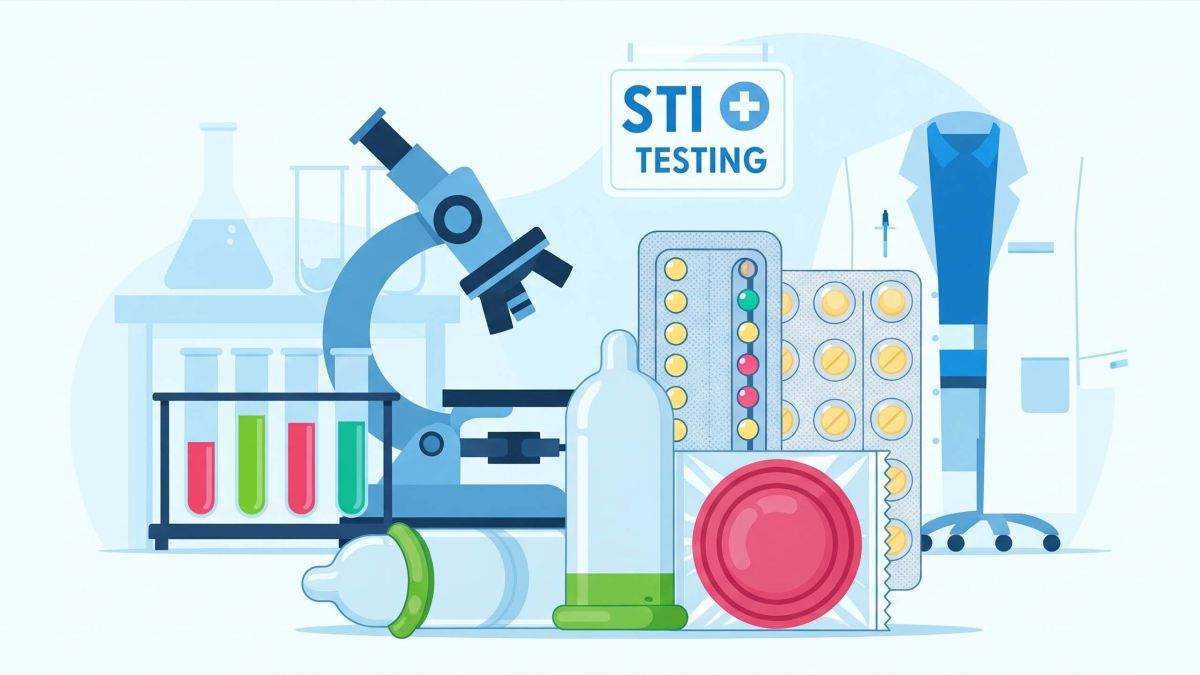Safe Sex Essentials: A Comprehensive Guide to Protection and Prevention

In a world where relationships and intimacy take many forms, making informed choices about sexual health remains a practical step toward well-being. Whether you're in a long-term partnership, exploring new connections, or simply prioritizing your health, understanding safe sex practices can help reduce risks and foster confidence.
This guide covers the basics of protection against unintended pregnancy and sexually transmitted infections (STIs), along with tips for maintaining open communication. Drawing from established health resources, we'll break down methods, strategies, and common misconceptions to provide a clear, straightforward overview.
The Basics: Why Safe Sex Matters
Safe sex isn't just about avoiding problems—it's about enjoying intimacy with fewer worries. Unprotected sexual activity can lead to unintended pregnancies or STIs, which affect millions worldwide each year. According to the World Health Organization, more than 30 different bacteria, viruses, and parasites can be transmitted through vaginal, anal, or oral sex. In the United States alone, rates of certain STIs have been on the rise, highlighting the need for consistent prevention efforts.
The good news is that many risks are manageable with the right tools and habits. Protection methods can prevent pregnancy, while prevention strategies like testing and vaccination address STIs. Peace of mind comes from knowing your options, discussing them with partners, and staying proactive about health check-ups. No one approach fits everyone, so consider your lifestyle, health history, and preferences when choosing what works best.
Understanding the Risks Involved
Before exploring solutions, it's helpful to recognize what you're protecting against. Unintended pregnancy occurs when sperm fertilizes an egg without planning, often due to lack of contraception. STIs, on the other hand, spread through bodily fluids or skin-to-skin contact during sexual activity. Common ones include chlamydia, gonorrhea, syphilis, herpes, human papillomavirus (HPV), and HIV.
Many STIs show no symptoms at first, which is why regular screening is key. Untreated infections can lead to complications like infertility, chronic pain, or increased risk of other health issues. For instance, HPV can cause cervical cancer if not addressed, but vaccines offer strong protection. HIV, while manageable with treatment, requires lifelong care to prevent progression to AIDS.
Risk levels vary based on factors like the number of partners, type of sexual activity, and use of protection. Anal sex carries a higher STI transmission risk than vaginal sex, and oral sex can transmit certain infections too. The key is awareness: knowing these risks allows for better decision-making without fear or judgment.
Protection Methods: Choosing Contraception That Fits Your Life
Contraception prevents pregnancy by blocking sperm from reaching an egg or altering hormonal cycles. Options range from short-term barriers to long-acting devices. Effectiveness depends on correct use—methods like implants are over 99% effective, while others require more consistency. Here's a breakdown of common types, including their advantages and drawbacks, to help you weigh your choices.
Barrier Methods
These create a physical block to sperm and can also reduce STI transmission.
- External Condoms: Made of latex or polyurethane, they fit over the penis. Effectiveness: About 87% with typical use. Pros: Widely available without a prescription, inexpensive (often $0–$2 each), and they help prevent STIs during vaginal, anal, or oral sex. Cons: Must be used every time, and they can break or slip if not handled properly. Some people experience reduced sensation.
- Internal Condoms: Inserted into the vagina or anus. Effectiveness: Around 79%. Pros: No hormones involved, and they offer STI protection. Cons: Slightly less effective than external condoms and may require practice to insert correctly.
- Other Barriers: Diaphragms, cervical caps, or sponges are less common but provide options. Pros: Reusable in some cases and hormone-free. Cons: Lower effectiveness (around 76–88%) and need fitting by a healthcare provider.
| Method | Type | Effectiveness | Pros | Cons | STI Protection |
|---|---|---|---|---|---|
| External Condoms | Barrier | 87% | Available without prescription, inexpensive, prevents STIs | Must be used every time, can break | Yes |
| Internal Condoms | Barrier | 79% | Hormone-free, prevents STIs | Less effective, requires practice | Yes |
| Birth Control Pills | Hormonal | 93% | Regulates periods, reduces cramps | Daily use, prescription needed, side effects | No |
| Patch | Hormonal | 93% | Weekly application, lightens periods | Visible, skin irritation | No |
| Vaginal Ring | Hormonal | 93% | Monthly insertion, similar to pill benefits | Insertion required, possible discomfort | No |
| Shot | Hormonal | 96% | Every 3 months, reduces periods | Doctor visits, possible weight gain | No |
| Implant | LARC | 99% | Long-lasting (up to 5 years), no daily effort | Insertion procedure, irregular bleeding | No |
| IUD | LARC | 99% | Long-lasting (3-12 years), effective | Insertion discomfort, rare expulsion | No |
| Sterilization | Permanent | Nearly 100% | Permanent solution | Surgical, hard to reverse | No |
| Emergency Contraception | Emergency | Up to 95% | Reduces pregnancy risk after unprotected sex | Not for regular use, no STI protection | No |
Hormonal Methods
These use hormones like progestin or estrogen to prevent ovulation or thicken cervical mucus.
- Birth Control Pills: Taken daily. Effectiveness: 93%. Pros: Regulate periods, reduce cramps, and can help with acne; progestin-only versions (mini-pills) avoid estrogen. Cons: Require a prescription and daily routine; missing doses lowers effectiveness. Side effects might include nausea or mood changes.
- Patch: Applied to the skin weekly. Effectiveness: 93%. Pros: Easy to use, lightens periods, and allows skipping them. Cons: Visible on skin, potential irritation, and needs weekly replacement.
- Vaginal Ring: Inserted monthly. Effectiveness: 93%. Pros: Similar benefits to the pill and patch, with less frequent changes. Cons: Requires insertion and removal; some report vaginal discomfort.
- Shot: Injected every three months. Effectiveness: 96%. Pros: Progestin-only, reduces periods over time. Cons: Needs regular doctor visits; possible weight gain or bone density changes with long-term use.
Long-Acting Reversible Contraception (LARC)
These are set-it-and-forget-it options inserted by a professional.
- Implant: A small rod placed under the arm's skin. Effectiveness: 99%, lasts up to five years. Pros: Highly reliable, lightens or stops periods, no daily effort. Cons: Insertion procedure, possible irregular bleeding initially.
- Intrauterine Device (IUD): T-shaped device in the uterus. Effectiveness: 99%, lasts 3–12 years. Pros: Extremely effective; hormonal versions lighten periods, copper ones are hormone-free. Cons: Insertion can be uncomfortable; rare risks like expulsion.
Permanent and Emergency Options
- Sterilization: Tubal ligation or vasectomy. Effectiveness: Nearly 100%. Pros: Permanent solution for those done having children. Cons: Surgical, hard to reverse.
- Emergency Contraception: Pills or copper IUD after unprotected sex. Pros: Reduces pregnancy risk by up to 95% if taken soon. Cons: Not for regular use; doesn't protect against STIs.
Consult a healthcare provider to match methods to your needs, especially if you have conditions like high blood pressure.
Prevention Strategies: Guarding Against STIs
While contraception handles pregnancy, STI prevention requires additional steps. The Centers for Disease Control and Prevention (CDC) emphasizes consistent condom use, vaccination, and reducing partners as core strategies.
- Condoms and Barriers: As mentioned, they block fluid exchange. Use them correctly—check expiration dates, use lube to prevent tears.
- Vaccination: Get shots for HPV (prevents warts and cancers), hepatitis B, and hepatitis A if at risk. The CDC recommends HPV vaccination for preteens but catch-up doses up to age 26 or older in some cases.
- Pre-Exposure Prophylaxis (PrEP): Daily pills or injections reduce HIV risk by 99% for those at higher exposure. Post-exposure prophylaxis (PEP) is for emergencies.
- Limiting Partners and Mutual Testing: Fewer partners lowers risk. It's common and reasonable for anyone—man or woman—to ask a new partner to get tested for STIs before having sex. This can be set as a straightforward prerequisite, much like discussing contraception preferences. For example, you might say, "Before we take things further, I'd like us both to get recent STI tests to make sure we're on the same page." Many people view this as a standard part of building trust with someone new, and it helps ensure both parties start with clear information. Results can be shared mutually, and free or low-cost testing is available at clinics.
Emerging options like doxycycline post-exposure prophylaxis (doxy-PEP) show promise for bacterial STIs, but consult a doctor.
Testing and Health Check-Ups: Staying Ahead
Regular testing catches issues early. The CDC advises annual screening for chlamydia and gonorrhea in sexually active women under 25, and HIV for all adults. Men who have sex with men or those with multiple partners may need more frequent tests.
Home tests are available for some STIs, but clinic visits ensure accuracy. If positive, treatments like antibiotics cure many bacterial infections. Notify partners anonymously if needed through services like those from health departments.
Communication and Consent: Building Trust
Safe sex starts with conversation. Talk about boundaries, STI history, and protection preferences openly. Including a request for recent STI testing as a normal step with new partners fits right into these discussions—it shows care for each other's health without making assumptions. Consent means enthusiastic agreement every time—it's ongoing and can be withdrawn.
Relatable scenarios: If you're nervous, start with "I want us both to feel comfortable—what are your thoughts on testing?" This builds mutual respect and reduces anxiety.
Busting Common Myths
Misinformation can lead to mistakes. Here are facts to set the record straight:
- Myth: You can't get STIs from oral sex.
Fact: Infections like herpes, gonorrhea, and syphilis can transmit this way. - Myth: Pulling out prevents pregnancy and STIs.
Fact: Pre-ejaculate can contain sperm and viruses; it's unreliable. - Myth: Doubling up on condoms is safer.
Fact: It increases friction and breakage risk. - Myth: Showers or douching after sex prevents issues.
Fact: They don't remove sperm or pathogens effectively and can disrupt natural balances. - Myth: You can tell if someone has an STI by looking.
Fact: Many are asymptomatic.
Wrapping Up: Steps Toward Confidence
Safe sex combines knowledge, tools, and habits for protection, prevention, and peace of mind. Start by assessing your risks, choosing suitable methods, and scheduling check-ups. Resources like the CDC or local clinics offer free or low-cost services. Remember, everyone's situation is unique—what matters is making choices that align with your life. With these practices, intimacy can be enjoyable and worry-free. If questions arise, reach out to a trusted healthcare provider for personalized advice.
Safe Sex Q&A
What is the most effective way to prevent both pregnancy and STIs?
Using condoms consistently and correctly, combined with another form of contraception if needed, provides dual protection.
How often should I get tested for STIs?
The CDC recommends annual testing for sexually active individuals under 25, or more frequently if at higher risk, such as with multiple partners.
Can birth control pills protect against STIs?
No, hormonal methods like pills do not prevent STIs; they only help prevent pregnancy.
What should I do if a condom breaks?
Seek emergency contraception within 72-120 hours to prevent pregnancy, and get tested for STIs.
Is it normal to feel nervous talking about STI testing with a partner?
Yes, but starting with "I care about our health—let's get tested together" can make it easier and build trust.
What myths about safe sex are common?
Myths include believing oral sex can't transmit STIs or that pulling out is reliable—both are false.
How can I access free or low-cost sexual health services?
Check resources like the CDC website, local clinics, or Planned Parenthood for affordable testing and contraception.
Disclaimer: The articles and information provided by the Vagina Institute are for informational and educational purposes only. This content is not intended to be a substitute for professional medical advice, diagnosis, or treatment. Always seek the advice of your physician or another qualified health provider with any questions you may have regarding a medical condition.


 English
English  Deutsch
Deutsch  Español
Español  Français
Français 




